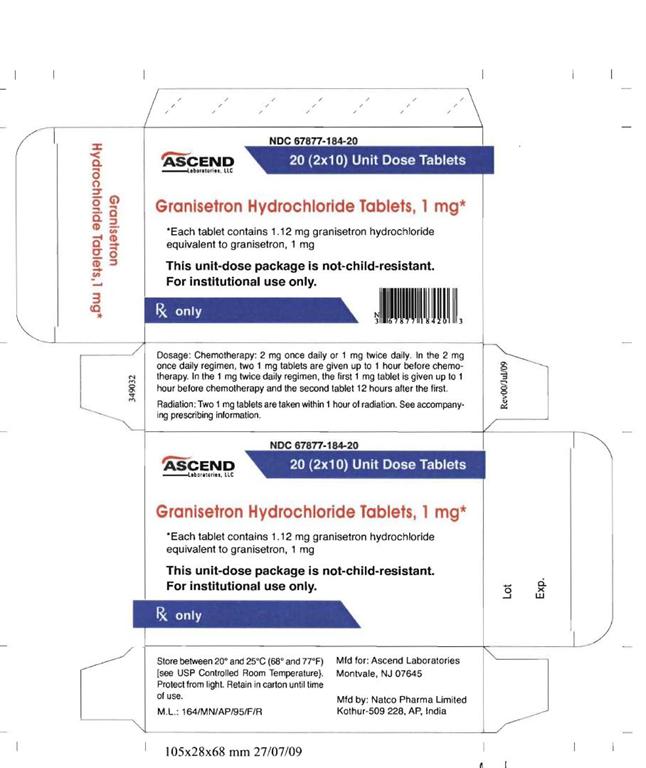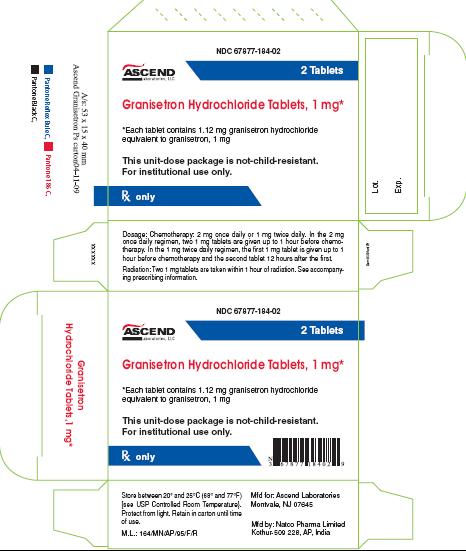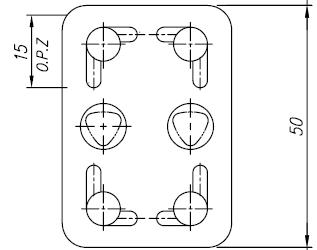Label: GRANISETRON HYDROCHLORIDE tablet
-
Contains inactivated NDC Code(s)
NDC Code(s): 67877-184-02, 67877-184-20 - Packager: Ascend Laboratories, LLC
- Category: HUMAN PRESCRIPTION DRUG LABEL
- DEA Schedule: None
- Marketing Status: Abbreviated New Drug Application
Drug Label Information
Updated March 21, 2011
If you are a consumer or patient please visit this version.
- Download DRUG LABEL INFO: PDF XML
- Official Label (Printer Friendly)
- RX Only
-
DESCRIPTION
Granisetron HCL tablets contain granisetron hydrochloride, an antinauseant and antiemetic agent. Chemically it is endo-N-(9-methyl-9-azabicyclo [3.3.1] non-3-yl)-1-methyl-1H-indazole-3-carboxamide hydrochloride with a molecular weight of 348.9 (312.4 free base). Its empirical formula is C18H24N4O•HCl, while its chemical structure is:
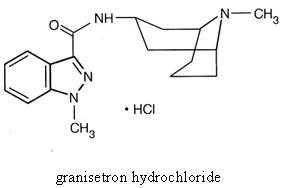
Granisetron hydrochloride is a white to off-white solid that is readily soluble in water and normal saline at 20°C.Tablets for Oral Administration
Each white, triangular, biconvex, film-coated Granisetron HCl Tablet contains 1.12 mg granisetron hydrochloride equivalent to granisetron, 1 mg. Inactive ingredients are: hyprmellose, lactose monohydrate, magnesium stearate, microcrystalline cellulose, polyethylene glycol, polysorbate 80, sodium starch glycolate and titanium dioxide.
-
CLINICAL PHARMACOLOGY
Granisetron is a selective 5-hydroxytryptamine3 (5-HT3) receptor antagonist with little or no affinity for other serotonin receptors, including 5-HT1; 5-HT1A; 5-HT1B/C; 5-HT2; for alpha1-, alpha2-, or beta-adrenoreceptors; for dopamine-D2; or for histamine-H1; benzodiazepine; picrotoxin or opioid receptors.
Serotonin receptors of the 5- HT3 type are located peripherally on vagal nerve terminals and centrally in the chemoreceptor trigger zone of the area postrema. During chemotherapy that induces vomiting, mucosal enterochromaffin cells release serotonin, which stimulates 5-HT3 receptors. This evokes vagal afferent discharge, inducing vomiting. Animal studies demonstrate that, in binding to 5-HT3 receptors, granisetron blocks serotonin stimulation and subsequent vomiting after emetogenic stimuli such as cisplatin. In the ferret animal model, a single granisetron injection prevented vomiting due to high-dose cisplatin or arrested vomiting within 5 to 30 seconds.
In most human studies, granisetron has had little effect on blood pressure, heart rate or ECG. No evidence of an effect on plasma prolactin or aldosterone concentrations has been found in other studies.
Following single and multiple oral doses, Granisetron HCl Tablets slowed colonic transit in normal volunteers. However, Granisetron HCl had no effect on oro-cecal transit time in normal volunteers when given as a single intravenous (IV) infusion of 50 mcg/kg or 200 mcg/kg.
Pharmacokinetics
In healthy volunteers and adult cancer patients undergoing chemotherapy, administration of Granisetron HCl Tablets produced mean pharmacokinetic data shown in Table 1.Table 1 Pharmacokinetic Parameters (Median [range]). Following Granisetron HCl Tablets
*Not determined after oral administration; following a single intravenous dose of 40 mcg/kg, terminal phase half-life was determined to be 8.95 hours
N.D. Not determined
Peak Plasma Concentration
(ng/mL)
Terminal Phase Plasma Half-Life
(h)
Volume of Distribution
(L/kg)
Total Clearance
(L/h/kg)
Cancer Patients
1 mg bid, 7 days
(n=27)
5.99
[0.63 to 30.9]
N.D.*
N.D.
0.52
[0.09 to 7.37]
Volunteers
single 1 mg dose
(n=39)
3.63
[0.27 to 9.14]
6.23
[0.96 to 19.9]
3.94
[1.89 to 39.4]
0.41
[0.11 to 24.6]
AbsorptionWhen Granisetron hydrochloride tablets were administered with food, AUC was decreased by 5% and Cmax increased by 30% in non-fasted healthy volunteers who received a single dose of 10 mg.
Distribution
Plasma protein binding is approximately 65% and granisetron distributes freely between plasma and red blood cells.
Metabolism
Granisetron metabolism involves N-demethylation and aromatic ring oxidation followed by conjugation. In vitro liver microsomal studies show that granisetron's major route of metabolism is inhibited by ketoconazole, suggestive of metabolism mediated by the cytochrome P-450 3A subfamily. Animal studies suggest that some of the metabolites may also have 5-HT3 receptor antagonist activity.
Elimination
Clearance is predominantly by hepatic metabolism. In normal volunteers, approximately 11% of the orally administered dose is eliminated unchanged in the urine in 48 hours. The remainder of the dose is excreted as metabolites, 48% in the urine and 38% in the feces.
Subpopulation
Gender
The effects of gender on the pharmacokinetics of Granisetron HCl Tablets have not been studied. However, after intravenous infusion of Granisetron HCl, no difference in mean AUC was found between males and females, although males had a higher Cmax generally.
In elderly and pediatric patients and in patients with renal failure or hepatic impairment, the pharmacokinetics of granisetron was determined following administration of intravenous granisetron hydrochloride.
ElderlyThe ranges of the pharmacokinetic parameters in elderly volunteers (mean age 71 years), given a single 40 mcg/kg intravenous dose of granisetron hydrochloride injection, were generally similar to those in younger healthy volunteers; mean values were lower for clearance and longer for half-life in the elderly.
Renal Failure PatientsTotal clearance of granisetron was not affected in patients with severe renal failure who received a single 40 mcg/kg intravenous dose of granisetron hydrochloride Injection.
Hepatically Impaired Patients: A pharmacokinetic study with intravenous granisetron hydrochloride in patients with hepatic impairment due to neoplastic liver involvement showed that total clearance was approximately halved compared to patients without hepatic impairment. Given the wide variability in pharmacokinetic parameters noted in patients and the good tolerance of doses well above the recommended dose, dosage adjustment in patients with possible hepatic functional impairment is not necessary.
Pediatric Patients: A pharmacokinetic study in pediatric cancer patients (2 to 16 years of age), given a single 40 mcg/kg intravenous dose of granisetron hydrochloride Injection, showed that volume of distribution and total clearance increased with age. No relationship with age was observed for peak plasma concentration or terminal phase plasma half-life. When volume of distribution and total clearance are adjusted for body weight, the pharmacokinetics of granisetron are similar in pediatric and adult cancer patients. -
Clinical Trials
Chemotherapy-Induced Nausea and vomiting
Granisetron HCl Tablets prevent nausea and vomiting associated with initial and repeat courses of emetogenic cancer therapy, as shown by 24-hour efficacy data from studies using both moderately- and highly-emetogenic chemotherapy.
Moderately Emetogenic Chemotherapy
The first trial compared Granisetron HCl tablets doses of 0.25 mg to 2 mg bid, in 930 cancer patients receiving, principally, cyclophosphamide, carboplatin, and cisplatin (20 mg/m2 to 50 mg/m2). Efficacy was based on complete response (ie, no vomiting, no moderate or severe nausea, no rescue medication), no vomiting, and no nausea. Table 2 summarizes the results of this study.
Table 2 Prevention of Nausea and Vomiting 24 Hours Post-Chemotherapy* - *
- Chemotherapy included oral and injectable cyclophosphamide, carboplatin, cisplatin (20 mg/m2 to 50 mg/m2), dacarbazine, doxorubicin, epirubicin.
- †
- No vomiting, no moderate or severe nausea, no rescue medication.
- ‡
- Statistically significant (P<0.01) vs. 0.25 mg bid.
- §
- Statistically significant (P<0.01) vs. 0.5 mg bid.
Percentages of Patients
Granisetron HCl Tablet DoseEfficacy Measures
0.25 mg bid
(n=229)
%
0.5 mg bid
(n=235)
%
1 mg bid
(n=233)
%
2 mg bid
(n=233)
%
Complete Response†
61
70‡
81‡§
72‡
No Vomiting
66
77‡
88‡
79‡
No Nausea
48
57
63‡
54
Results from a second double-blind, randomized trial evaluating Granisetron HCl Tablets 2 mg qd and Granisetron HCl Tablets 1 mg bid were compared to prochlorperazine 10 mg bid derived from a historical control. At 24 hours, there was no statistically significant difference in efficacy between the two Granisetron HCl Tablet regimens. Both regimens were statistically superior to the prochlorperazine control regimen (see Table 3).
Table 3 Prevention of Nausea and Vomiting 24 Hours Post-Chemotherapy* - *
- Moderately emetogenic chemotherapeutic agents included cisplatin (20 mg/m2 to 50 mg/m2), oral and intravenous cyclophosphamide, carboplatin, dacarbazine, doxorubicin.
- †
- Historical control from a previous double-blind granisetron hydrochloride trial.
- ‡
- No vomiting, no moderate or severe nausea, no rescue medication
- §
- Statistically significant (P<0.05) vs. prochlorperazine historical control.
- ¶
- No vomiting, no nausea, no rescue medication.
Percentages of Patients Efficacy Measures
Granisetron HCl tablets
1 mg bid
(n = 354)
%
Granisetron HCltablets
2 mg qd
(n = 343)
%
Prochlorperazine†
10 mg bid
(n=111)
%
Complete Response‡
69§
64§
41
No Vomiting
82§
77§
48
No Nausea
51§
53§
35
Total Control¶
51§
50§
33
Results from a Granisetron HCl Tablets 2 mg qd alone treatment arm in a third double-blind, randomized trial, were compared to prochlorperazine (PCPZ), 10 mg bid, derived from a historical control. The 24-hour results for Granisetron HCl Tablets 2 mg qd were statistically superior to PCPZ for all efficacy parameters: complete response (58%), no vomiting (79%), no nausea (51%), total control (49%). The PCPZ rates are shown in Table 3.
Cisplatin -Based Chemotherapy
The first double-blind trial compared Granisetron HCl Tablets 1 mg bid, relative to placebo (historical control), in 119 cancer patients receiving high-dose cisplatin (mean dose 80 mg/m2). At 24 hours, Granisetron HCl Tablets 1 mg bid was significantly (P<0.001) superior to placebo (historical control) in all efficacy parameters: complete response (52%), no vomiting (56%) and no nausea (45%). The placebo rates were 7%, 14%, and 7%, respectively, for the three efficacy parameters.
Results from a Granisetron HCl Tablets 2 mg qd alone treatment arm in a second double-blind, randomized trial, were compared to both Granisetron HCl Tablets 1 mg bid and placebo historical controls. The 24-hour results for Granisetron HCl Tablets 2 mg qd were: complete response (44%), no vomiting (58%), no nausea (46%), total control (40%). The efficacy of Granisetron HCl Tablets 2 mg qd was comparable to Granisetron HCl Tablets 1 mg bid and statistically superior to placebo. The placebo rates were 7%, 14%, 7%, and 7%, respectively, for the four parameters.
No controlled study comparing granisetron injection with the oral formulation to prevent chemotherapy-induced nausea and vomiting has been performed.
Radiation-Induced Nausea and Vomiting
Total Body Irradiation
In a double-blind randomized study, 18 patients receiving granisetron hydrochloride tablets, 2 mg daily, experienced significantly greater antiemetic protection compared to patients in a historical negative control group who received conventional (non-5-HT3 antagonist) antiemetics. Total body irradiation consisted of 11 fractions of 120 cGy administered over 4 days, with three fractions on each of the first 3 days, and two fractions on the fourth day. Granisetron HCl Tablets were given one hour before the first radiation fraction of each day.
Twenty-two percent (22%) of patients treated with Granisetron HCl Tablets did not experience vomiting or receive rescue antiemetics over the entire 4-day dosing period, compared to 0% of patients in the historical negative control group (P<0.01).
In addition, patients who received Granisetron HCl Tablets also experienced significantly fewer emetic episodes during the first day of radiation and over the 4-day treatment period, compared to patients in the historical negative control group. The median time to the first emetic episode was 36 hours for patients who received granisetron hydrochloride tablets.Fractionated Abdominal Radiation
The efficacy of Granisetron HCl Tablets, 2 mg daily, was evaluated in a double-blind, placebo-controlled randomized trial of 260 patients. Granisetron HCl Tablets were given 1 hour before radiation, composed of up to 20 daily fractions of 180 to 300 cGy each. The exceptions were patients with seminoma or those receiving whole abdomen irradiation who initially received 150 cGy per fraction. Radiation was administered to the upper abdomen with a field size of at least 100 cm2.
The proportion of patients without emesis and those without nausea for Granisetron HCl Tablets, compared to placebo, was statistically significant (P<0.0001) at 24 hours after radiation, irrespective of the radiation dose. Granisetron HCl was superior to placebo in patients receiving up to 10 daily fractions of radiation, but was not superior to placebo in patients receiving 20 fractions.
Patients treated with Granisetron HCl Tablets (n=134) had a significantly longer time to the first episode of vomiting (35 days vs. 9 days, P<0.001) relative to those patients who received placebo (n=126), and a significantly longer time to the first episode of nausea (11 days vs. 1 day, P<0.001). Granisetron HCl provided significantly greater protection from nausea and vomiting than placebo.
- INDICATIONS & USAGE
- CONTRAINDICATIONS
-
PRECAUTIONS
Granisetron HCl is not a drug that stimulates gastric or intestinal peristalsis. It should not be used instead of nasogastric suction. The use of Granisetron HCl in patients following abdominal surgery or in patients with chemotherapy-induced nausea and vomiting may mask a progressive ileus and/or gastric distention.
Drug Interactions
Granisetron does not induce or inhibit the cytochrome P-450 drug-metabolizing enzyme system in vitro. There have been no definitive drug-drug interaction studies to examine pharmacokinetic or pharmacodynamic interaction with other drugs; however, in humans, Granisetron hydrochloride Injection has been safely administered with drugs representing benzodiazepines, neuroleptics, and anti-ulcer medications commonly prescribed with antiemetic treatments. Granisetron hydrochloride Injection also does not appear to interact with emetogenic cancer chemotherapies. Because granisetron is metabolized by hepatic cytochrome P-450 drug-metabolizing enzymes, inducers or inhibitors of these enzymes may change the clearance and, hence, the half-life of granisetron. No specific interaction studies have been conducted in anesthetized patients. In addition, the activity of the cytochrome P-450 subfamily 3A4 (involved in the metabolism of some of the main narcotic analgesic agents) is not modified by granisetron hydrochloride in vitro.
In in vitro human microsomal studies, ketoconazole inhibited ring oxidation of Granisetron HCl. However, the clinical significance of in vivo pharmacokinetic interactions with ketoconazole is not known. In a human pharmacokinetic study, hepatic enzyme induction with phenobarbital resulted in a 25% increase in total plasma clearance of intravenous Granisetron HCl. The clinical significance of this change is not known.Carcinogenesis, Mutagenesis, Impairment Of Fertility
In a 24-month carcinogenicity study, rats were treated orally with granisetron 1, 5 or 50 mg/kg/day (6, 30 or 300 mg/m2/day). The 50mg/kg/day dose was reduced to 25 mg/kg/day (150 mg/m2/day) during week 59 due to toxicity. For a 50 kg person of average height (1.46 m2 body surface area), these doses represent 4, 20, and 101 times the recommended clinical dose (1.48 mg/m2, oral) on a body surface area basis. There was a statistically significant increase in the incidence of hepatocellular carcinomas and adenomas in males treated with 5 mg/kg/day (30 mg/m2/day, 20 times the recommended human dose based on body surface area) and above, and in females treated with 25 mg/kg/day (150 mg/m2/day, 101 times the recommended human dose based on body surface area). No increase in liver tumors was observed at a dose of 1 mg/kg/day (6 mg/m2/day, 4 times the recommended human dose based on body surface area) in males and 5 mg/kg/day (30 mg/m2/day, 20 times the recommended human dose based on body surface area) in females. In a 12-month oral toxicity study, treatment with granisetron 100 mg/kg/day (600 mg/m2/day, 405 times the recommended human dose based on body surface area) produced hepatocellular adenomas in male and female rats while no such tumors were found in the control rats. A 24-month mouse carcinogenicity study of granisetron did not show a statistically significant increase in tumor incidence, but the study was not conclusive.
Because of the tumor findings in rat studies, granisetron hydrochloride should be prescribed only at the dose and for the indication recommended (see INDICATIONS AND USAGE, and DOSAGE AND ADMINISTRATION).
Granisetron was not mutagenic in in vitro Ames test and mouse lymphoma cell forward mutation assay, and in vivo mouse micronucleus test and in vitro and ex vivo rat hepatocyte UDS assays. It, however, produced a significant increase in UDS in HeLa cells in vitro and a significant increased incidence of cells with polyploidy in an in vitro human lymphocyte chromosomal aberration test.
Granisetron at oral doses up to 100 mg/kg/day (600 mg/m2/day, 405 times the recommended human dose based on body surface area) was found to have no effect on fertility and reproductive performance of male and female rats.Pregnancy
Teratogenic Effects
Pregnancy Category B.
Reproduction studies have been performed in pregnant rats at oral doses up to 125 mg/kg/day (750 mg/m2/day, 507 times the recommended human dose based on body surface area) and pregnant rabbits at oral doses up to 32 mg/kg/day (378 mg/m2/day, 255 times the recommended human dose based on body surface area) and have revealed no evidence of impaired fertility or harm to the fetus due to granisetron. There are, however, no adequate and well-controlled studies in pregnant women. Because animal reproduction studies are not always predictive of human response, this drug should be used during pregnancy only if clearly needed. -
ADVERSE REACTIONS
Chemotherapy-Induced Nausea and Vomiting
Over 3700 patients have received Granisetron HCl Tablets in clinical trials with emetogenic cancer therapies consisting primarily of cyclophosphamide or cisplatin regimens.
In patients receiving GranisetronHCl Tablets 1 mg bid for 1, 7 or 14 days, or 2 mg qd for 1 day, adverse experiences reported in more than 5% of the patients with comparator and placebo incidences are listed in Table 4.
Other adverse events reported in clinical trials were:Table 4 Principal Adverse Events in Clinical Trials
- *
- Adverse events were recorded for 7 days when granisetron hydrochloride tablets were given on a single day and for up to 28 days when granisetron hydrochloride tablets were administered for 7 or 14 days.
- †
- Metoclopramide/dexamethasone; phenothiazines/dexamethasone; dexamethasone alone; prochlorperazine.
- ‡
- Usually mild to moderate in severity.
Percent of Patients With Event
Granisetron HCl* tablets
1 mg bid
(n=978)
Granisetron HCl*
tablets
2mg qd
(n=1450)Comparator†
(n=599)
Placebo
(n=185)
Headache‡
21%
20%
13%
12%
Constipation
18%
14%
16%
8%
Asthenia
14%
18%
10%
4%
Diarrhea
8%
9%
10%
4%
Abdominal pain
6%
4%
6%
3%
Dyspepsia
4%
6%
5%
4%
Gastrointestinal:In single-day dosing studies in which adverse events were collected for 7 days, nausea (20%) and vomiting (12%) were recorded as adverse events after the 24-hour efficacy assessment period.
Hepatic:In comparative trials, elevation of AST and ALT (>2 times the upper limit of normal) following the administration of granisetron hydrochloride tablets occurred in 5% and 6% of patients, respectively. These frequencies were not significantly different from those seen with comparators (AST: 2%; ALT: 9%).
Cardiovascular:Hypertension (1%); hypotension, angina pectoris, atrial fibrillation, and syncope have been observed rarely.
Central Nervous System:Dizziness (5%), insomnia (5%), anxiety (2%), somnolence (1%). One case compatible with, but not diagnostic of, extrapyramidal symptoms have been reported in a patient treated with Granisetron HCl Tablets.
Hypersensitivity:Rare cases of hypersensitivity reactions, sometimes severe (eg, anaphylaxis, shortness of breath, hypotension, urticaria) have been reported.
Other:Fever (5%). Events often associated with chemotherapy also have been reported: leukopenia(9%), decreased appetite (6%), anemia (4%), alopecia (3%), thrombocytopenia (2%).
Over 5000 patients have received injectable granisetron hydrochloride in clinical trials.
Table 5gives the comparative frequencies of the five commonly reported adverse events (≥3%) in patients receiving granisetron hydrochloride Injection, 40 mcg/kg, in single-day chemotherapy trials. These patients received chemotherapy, primarily cisplatin, and intravenous fluids during the 24-hour period following granisetron hydrochloride Injection administration.
Percent of Patients with Event
Granisetron hydrochloride* Injection
40 mcg/kg
(n=1268)
Comparator†
(n=422)
Headache
14%
6%
Asthenia
5%
6%
Somnolence
4%
15%
Diarrhea
4%
6%
Constipation
3%
3%
In the absence of a placebo group, there is uncertainty as to how many of these events should be attributed to granisetron hydrochloride, except for headache, which was clearly more frequent than in comparison groups.Radiation-Induced Nausea and Vomiting
In controlled clinical trials, the adverse events reported by patients receiving Granisetron HCl Tablets and concurrent radiation were similar to those reported by patients receiving Granisetron HCl Tablets prior to chemotherapy. The most frequently reported adverse events were diarrhea, asthenia, and constipation. Headache, however, was less prevalent in this patient population.
- OVERDOSAGE
-
DOSAGE & ADMINISTRATION
Emetogenic Chemotherapy
The recommended adult dosage of oral Granisetron HCl (granisetron hydrochloride) is 2 mg once daily or 1 mg twice daily. In the 2 mg once-daily regimen, two 1 mg tablets are given up to 1 hour before chemotherapy. In the 1 mg twice-daily regimen, the first 1 mg tablet is given up to 1 hour before chemotherapy, and the second tablet 12 hours after the first. Either regimen is administered only on the day(s) chemotherapy is given. Continued treatment, while not on chemotherapy, has not been found to be useful.
Use in the Elderly, Pediatric Patients, Renal Failure Patients or Hepatically Impaired PatientsNo dosage adjustment is recommended (see CLINICAL PHARMACOLOGY: Pharmacokinetics).
Radiation (Either Total Body Irradiation or Fractionated Abdominal Radiation)
The recommended adult dosage of oral granisetron hydrochloride is 2 mg once daily. Two 1 mg tablets are taken within 1 hour of radiation.
Pediatric UseThere is no experience with oral Granisetron HCl in the prevention of radiation-induced nausea and vomiting in pediatric patients.
Use in the Elderly
No dosage adjustment is recommended. -
HOW SUPPLIED
White colored, triangular shaped, biconvex, film-coated tablets with debossing of ‘1GN’ on one side and plain surface on the other side.
Granisetron HCl Tablets are available as 20 Unit Dose Tablets (Intended for institutional use only).NDC 67877-184-20-20’s pack
NDC 67877-184-02-2’s pack
Store between 20° and 25°C (68° and 77°F) (see USP Controlled Room Temperature). Keep container closed tightly. Protect form light.
ASCEND
Mfd for: Ascend LaboratoriesMontvale, NJ07645.
Mfd by: Natco Pharma Limited,
Kothur-509 228, A.P., India. -
Granisetron Hydrochloride Tablets-20 Tablets
RX Only
NDC67877-184-20
Each tablet contains 1.12 mg of granisetron Hydrochloride equivalent to granisetron, 1 mg.
This unit-dose package is not-child-resistant. For institutional use only.
Dosage: Chemotherapy: 2 mg once daily or 1mg twice daily. In the 2 mg once daily regimen, two 1 mg tablets are given up to 1 hour before chemotherapy. In the 1 mg twice daily regimen, the first 1 mg tablet is given up to 1 hour before chemotherapy and the second tablet 12 hours after the first.
Radiation: Two 1mg tablets are taken within 1 hour of radiation. See accompanying prescribing information.
Store between 20º and 25ºC (68º and 77ºF) [see USP Controlled Room Temperature]. Protect from light. Retain in carton until time of use.
M.L.: 164/MN/AP/95/F/R
Mfd for: Ascend Laboratories,
Montvale, NJ07645.
Mfd by: Natco Pharma Limited,
Kothur - 509 228, AP, India.
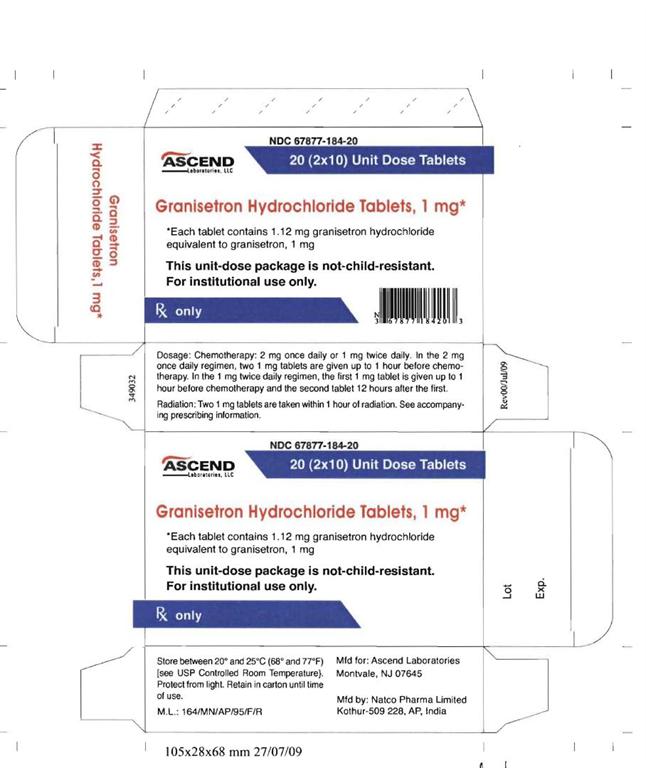
Blister Art Work
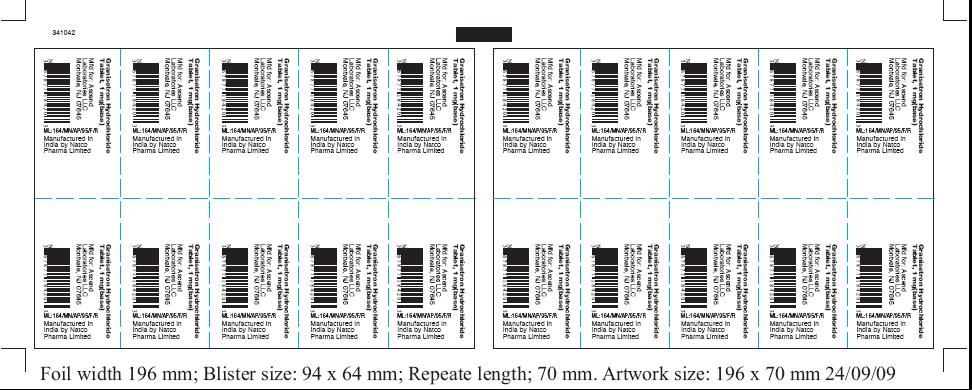
-
Granisetron Hydrochloride Tablets-2 Tablets
RX Only
NDC67877-184-02
Each tablet contains 1.12 mg of granisetron Hydrochloride equivalent to granisetron, 1 mg.
This unit-dose package is not-child-resistant. For institutional use only.
Dosage: Chemotherapy: 2 mg once daily or 1mg twice daily. In the 2 mg once daily regimen, two 1 mg tablets are given up to 1 hour before chemotherapy. In the 1 mg twice daily regimen, the first 1 mg tablet is given up to 1 hour before chemotherapy and the second tablet 12 hours after the first.
Radiation: Two 1mg tablets are taken within 1 hour of radiation. See accompanying prescribing information.
Store between 20º and 25ºC (68º and 77ºF) [See USP Controlled Room Temperature]. Protect from light. Retain in carton until time of use.
M.L.: 164/MN/AP/95/F/R
Mfd for: Ascend Laboratories,
Montvale, NJ07645.
Mfd by: Natco Pharma Limited,
Kothur - 509 228, AP, India.

Blister art work


-
INGREDIENTS AND APPEARANCE
GRANISETRON HYDROCHLORIDE
granisetron hydrochloride tabletProduct Information Product Type HUMAN PRESCRIPTION DRUG Item Code (Source) NDC:67877-184 Route of Administration ORAL Active Ingredient/Active Moiety Ingredient Name Basis of Strength Strength GRANISETRON HYDROCHLORIDE (UNII: 318F6L70J8) (GRANISETRON - UNII:WZG3J2MCOL) GRANISETRON HYDROCHLORIDE 1 mg Inactive Ingredients Ingredient Name Strength HYPROMELLOSES (UNII: 3NXW29V3WO) LACTOSE MONOHYDRATE (UNII: EWQ57Q8I5X) MAGNESIUM STEARATE (UNII: 70097M6I30) CELLULOSE, MICROCRYSTALLINE (UNII: OP1R32D61U) POLYETHYLENE GLYCOL 4000 (UNII: 4R4HFI6D95) POLYSORBATE 80 (UNII: 6OZP39ZG8H) SODIUM STARCH GLYCOLATE TYPE A POTATO (UNII: 5856J3G2A2) TITANIUM DIOXIDE (UNII: 15FIX9V2JP) Product Characteristics Color WHITE Score no score Shape TRIANGLE (bi convex) Size 7mm Flavor Imprint Code 1GN Contains Packaging # Item Code Package Description Marketing Start Date Marketing End Date 1 NDC:67877-184-20 20 in 1 BLISTER PACK 2 NDC:67877-184-02 2 in 1 BLISTER PACK Marketing Information Marketing Category Application Number or Monograph Citation Marketing Start Date Marketing End Date ANDA ANDA078969 01/01/2010 Labeler - Ascend Laboratories, LLC (141250469)

